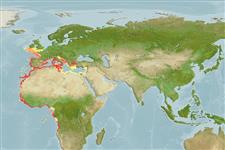Actinopterygii (ray-finned fishes) >
Scorpaeniformes (Scorpionfishes and flatheads) >
Peristediidae (Armored searobins or armored gurnards)
Etymology: Peristedion: Greek, peri = around + Greek, stethion = breast.
Environment / Climate / Range
Ecology
Marine; demersal; depth range 50 - 848 m (Ref. 56504), usually ? - 150 m (Ref. 10780). Deep-water, preferred ?; 52°N - 15°S, 18°W - 36°E
Eastern Atlantic: British Isles and English Channel to Angola, including the Mediterranean.
Length at first maturity / Size / Weight / Age
Maturity: Lm ?, range 22 - ? cm
Max length : 40.0 cm TL male/unsexed; (Ref. 3397); common length : 18.0 cm TL male/unsexed; (Ref. 3397)
Depth range from 50-600 m (Ref. 10780) and from 288-848 m in the eastern Ionian Sea (Ref. 56504). Gregarious. Occurs on muddy or rocky bottoms of the shelf. Digs the mud with its rostrum, searching for prey; stands and walks on the bottom with its free pectoral rays. After a pelagic existence, the juveniles live in coastal waters before migrating to deeper waters (Ref. 6556). Minimum depth range taken from Ref. 27000.
Life cycle and mating behavior
Maturity | Reproduction | Spawning | Eggs | Fecundity | Larvae
Wheeler, A., 1992. A list of the common and scientific names of fishes of the British Isles. J. Fish Biol. 41(suppl.A):1-37. (Ref. 5204)
IUCN Red List Status (Ref. 115185)
CITES (Ref. 94142)
Not Evaluated
Threat to humans
Harmless
Human uses
Fisheries: subsistence fisheries
More information
ReferencesAquacultureAquaculture profileStrainsGeneticsAllele frequenciesHeritabilityDiseasesProcessingMass conversion
Tools
Special reports
Download XML
Internet sources
